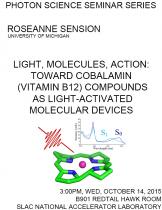Speaker: Roseanne J. Sension (Departments of Chemistry, Physics, and Biophysics, University of Michigan)
Program Description
Light is a versatile energy source. Sophisticated and increasingly compact laser sources are being developed that allow light pulses to be shaped, timed, tuned, focused, aimed and delivered at a target as required. These advances allow us to envision the development of practical optically controlled molecular scale devices in the not too distant future. Optically controlled molecular devices have potential applications as motors, switches, activators, junctions, memory, logic circuits, actuators, sensors, and delivery platforms. The function of these devices is controlled by photochemistry – photon energy produces action via movement of charge, change in molecular shape and bonding, or cleavage of a bond – light activates a change in the chemical nature of a molecular system. Cobalamin (Vitamin B12) compounds possess a novel, reactive C-Co bond. Photolysis of cobalamin based compounds have the potential for spatiotemporal control of drug delivery, light activated molecular switches, sensors, and as a source for controlled release of reactive radicals including alkyl radicals and hydroxyl radicals. Here we will present time-resolved spectroscopic measurements of a variety of cobalamin based systems, compare the results with state-of-the-art TD-DFT calculations of the excited state potential energy surfaces, and described planned time-resolved XAS measurements to further our understanding of the electronic states responsible for the observed photochemistry and photophysics.





